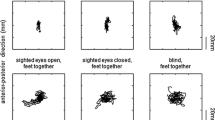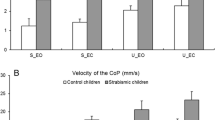Abstract
Background
Several studies have shown that achieving a dual task modifies postural control; however, their results are conflicting. The goal of the present study is to compare the effect of a simple task (eye fixation) to the effect of a dual task (saccadic eye movements) on postural balance in strabismic and in non strabismic children.
Methods
Postural stability was recorded with a platform (Techno Concept©) in ten strabismic children aged from 5.4 to 13.8 years (mean age: 8.8 ± 2.5 years). Data were compared to that of ten age-matched non strabismic control children. We analyzed the surface area, the length and the mean speed of the center of pressure (CoP).
Results
Strabismic children are more instable than control children. The surface (340 mm2), the length (402 mm) and the mean speed (16 mm/s) of the CoP are significantly higher in strabismic children than in control children (160 mm2, 280 mm and 11 mm/s, respectively). In addition, both strabismic and control children have a better postural control during saccades than during a fixation task. Surface, length and mean speed of the CoP are significantly reduced during the saccade task (214 mm2, 306 mm and 12.5 mm/s, respectively) than during the fixation task (285 mm2, 376 mm and 14.8 mm/s, respectively).
Conclusions
Abnormal postural control in strabismic children could be due to their visual deficits. The postural improvement observed in a dual task (saccades) vs. a simple task (fixation) might be due to the fact that postural control becomes more automatic during saccadic eye movements.

Similar content being viewed by others
References
Van Parys JA, Njiokiktjien CJ (1976) Romberg’s sign expressed in a quotient. Agressologie 17 SPECNO: 95–99
Black FO, Wall C 3rd, Nashner LM (1983) Effects of visual and support surface orientation references upon postural control in vestibular deficient subjects. Acta Otolaryngol 95:199–201
Brandt T (2003) Vertigo: Its Multisensory Syndromes. Springer
Friedrich M, Grein H-J, Wicher C, Schuetze J, Mueller A, Lauenroth A, Hottenrott K, Schwesig R (2007) Influence of pathologic and simulated visual dysfunctions on the postural system. Exp Brain Res 186:305–314
Peterka RJ (2002) Sensorimotor integration in human postural control. J Neurophys 88:1097–1118
Belen’kiĭ VE, Gurfinkel’ VS, Pal’tsev EI (1967) Control elements of voluntary movements. Biofizika 12:135–141
Blanchard Y, Carey S, Coffey J, Cohen A, Harris T, Michlik S, Pellecchia GL (2005) The Influence of Concurrent Cognitive Tasks on Postural Sway in Children. Pediatr Phys Ther 17:189–193
Palluel E, Nougier V, Olivier I (2010) Postural control and attentional demand during adolescence. Brain Res 1358:151–159
Woollacott M, Shumway-Cook A (2002) Attention and the control of posture and gait: a review of an emerging area of research. Gait Posture 16:1–14
Shumway-Cook A, Woollacott M (2000) Attentional demands and postural control: the effect of sensory context. J Gerontol A Biol Sci Med Sci 55:M10–16
Olivier I, Palluel E, Nougier V (2008) Effects of attentional focus on postural sway in children and adults. Exp Brain Res 185:341–345
Donker SF, Roerdink M, Greven AJ, Beek PJ (2007) Regularity of center-of-pressure trajectories depends on the amount of attention invested in postural control. Exp Brain Res 181:1–11
Roerdink M, De Haart M, Daffertshofer A, Donker SF, Geurts ACH, Beek PJ (2006) Dynamical structure of center-of-pressure trajectories in patients recovering from stroke. Exp Brain Res 174:256–269
Lajoie Y, Teasdale N, Bard C, Fleury M (1993) Attentional demands for static and dynamic equilibrium. Exp Brain Res 97:139–144
Assaiante C, Amblard B (1992) Peripheral vision and age-related differences in dynamic balance. Hum Mov Sci 11:533–548
Lee DN, Aronson E (1974) Visual proprioceptive control of standing in human infants. Atten Percept Psychophys 15:529–532
Butterworth G, Hicks L (1977) Visual proprioception and postural stability in infancy. A developmental study. Perception 6:255–262
Shumway-Cook A, Woollacott MH (1985) The growth of stability: postural control from a development perspective. J Mot Behav 17:131–147
Stoffregen TA, Schmuckler MA, Gibson EJ (1987) Use of central and peripheral optical flow in stance and locomotion in young walkers. Perception 16:113–119
Rizzolatti G, Riggio L, Dascola I, Umiltá C (1987) Reorienting attention across the horizontal and vertical meridians: evidence in favor of a premotor theory of attention. Neuropsychologia 25:31–40
Deubel H, Schneider WX (1996) Saccade target selection and object recognition: evidence for a common attentional mechanism. Vision Res 36:1827–1837
Belopolsky AV, Theeuwes J (2009) When are attention and saccade preparation dissociated? Psychol Sci 20:1340–1347
Leigh RJ, Zee DS (2006) The Neurology of Eye Movements. Oxford University Press, USA
Uchida T, Hashimoto M, Suzuki N, Takegami T, Iwase Y (1979) Effects of periodic saccades on the body sway in human subjects. Neurosci Lett 13:253–258
Rougier P, Garin M (2007) Performing saccadic eye movements or blinking improves postural control. Mot Control 11:213–223
Stoffregen TA, Bardy BG, Bonnet CT, Hove P, Oullier O (2007) Postural sway and the frequency of horizontal eye movements. Mot Control 11:86–102
White KD, Post RB, Leibowitz HW (1980) Saccadic eye movements and body sway. Science 208:621–623
Straube A, Paulus W, Quintern J, Brandt T (1989) Visual ataxia induced by eye movements: posturographic measurements in normals and patients with ocular motor disorders. Clin Vis Sci 4:107–113
Glasauer S, Schneider E, Jahn K, Strupp M, Brandt T (2005) How the eyes move the body. Neurology 65:1291–1293
Odenrick P, Sandstedt P, Lennerstrand G (1984) Postural sway and gait of children with convergent strabismus. Dev Med Child Neurol 26:495–499
Matsuo T, Yabuki A, Hasebe K, Shira YH, Imai S, Ohtsuki H (2010) Postural stability changes during the prism adaptation test in patients with intermittent and constant exotropia. Invest Ophthalmol Vis Sci 51:6341–6347
Legrand A, Bui Quoc E, Vacher SW, Ribot J, Lebas N, Milleret C, Bucci MP (2011) Postural control in children with strabismus: Effect of eye surgery. Neurosci Lett 501:96–101
Gagey P, Bizzo G, Bonnier L, Gentaz R, Guillaume P, Marucchi C, Villeneuve P (1993) Calculation of the statokinesigrame area (SKG). Eight lessons of Posturology, Paris
Vuillerme N, Chenu O, Pinsault N, Fleury A, Demongeot J, Payan Y (2008) Can a plantar pressure-based tongue-placed electrotactile biofeedback improve postural control under altered vestibular and neck proprioceptive conditions? Neuroscience 155:291–296
Geurts AC, Nienhuis B, Mulder TW (1993) Intrasubject variability of selected force-platform parameters in the quantification of postural control. Arch Phys Med Rehabil 74:1144–1150
Matsuo T, Narita A, Senda M, Hasebe S, Ohtsuki H (2006) Body sway increases immediately after strabismus surgery. Acta Medica Okayama 60:13
Lacour M, Bernard-Demanze L, Dumitrescu M (2008) Posture control, aging, and attention resources: Models and posture-analysis methods. Neurophysiol Clin/Clin Neurophysiol 38:411–421
Acknowledgments
The authors thank the children who participated in the study, Dr. Qing Yang and M. Nicolas Lebas for help in statistical analysis and Ms. Chloe Ann Barker for revising the English version of the manuscript.
Competing interests
The authors have declared that no competing interests exist.
Fundings
The authors have no support or funding to report.
Author information
Authors and Affiliations
Corresponding author
Rights and permissions
About this article
Cite this article
Lions, C., Bui-Quoc, E. & Bucci, M.P. Postural control in strabismic children versus non strabismic age-matched children. Graefes Arch Clin Exp Ophthalmol 251, 2219–2225 (2013). https://doi.org/10.1007/s00417-013-2372-x
Received:
Revised:
Accepted:
Published:
Issue Date:
DOI: https://doi.org/10.1007/s00417-013-2372-x




